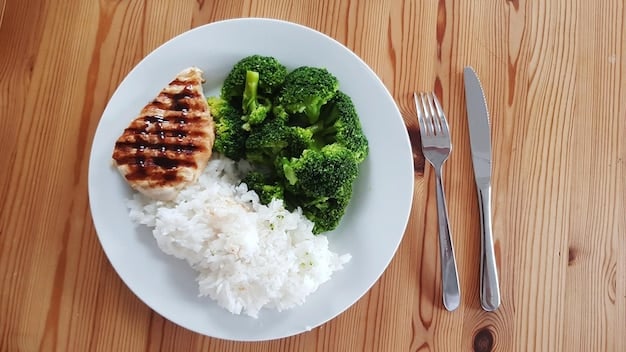Meal Planning for Athletes: Maximize Performance with Nutrition

Meal planning for athletes involves creating a structured dietary approach tailored to meet the unique energy and nutrient needs of athletic training and performance, optimizing recovery and overall health.
Are you an athlete looking to enhance your performance through nutrition? Meal planning for athletes is the key to fueling your body effectively and achieving peak performance. Let’s dive into how you can create a meal plan that supports your training goals.
Understanding the Nutritional Needs of Athletes
Athletes require a specific balance of macronutrients and micronutrients to support their high energy demands, muscle repair, and overall health. Understanding these needs is crucial to developing an effective meal plan.
Macronutrients: The Building Blocks
Macronutrients—carbohydrates, proteins, and fats—are essential for providing energy and supporting various bodily functions. The proportion of each macronutrient in an athlete’s diet should be tailored to their sport, training intensity, and individual needs.
Carbohydrates are the primary source of energy for high-intensity activities. Protein is crucial for muscle repair and growth. Healthy fats play a vital role in hormone production and nutrient absorption.
Micronutrients: The Vital Support System
Micronutrients, including vitamins and minerals, are essential for various physiological processes, such as energy metabolism, immune function, and bone health. Athletes need adequate amounts of these nutrients to maintain optimal performance and prevent deficiencies.
- Iron: Essential for oxygen transport and energy production.
- Calcium: Important for bone health and muscle function.
- Vitamin D: Crucial for calcium absorption and immune function.
- Antioxidants: Help combat oxidative stress caused by intense exercise.
Understanding the specific nutritional needs of athletes is the first step in creating an effective meal plan. Balancing macronutrients and ensuring adequate micronutrient intake will support overall health and performance.

Assessing Your Current Eating Habits
Before creating a meal plan, it’s important to assess your current eating habits. This involves tracking your food intake, identifying nutritional gaps, and understanding your body’s response to different foods.
Keeping a Food Journal
A food journal is a helpful tool for tracking your daily food intake. Record everything you eat and drink, including portion sizes, meal times, and any symptoms you experience after eating.
Be honest and detailed in your food journal. This will provide valuable insights into your current eating habits and help identify areas for improvement. Consistency is key to obtaining accurate data.
Identifying Nutritional Gaps
Once you have a clear picture of your current eating habits, you can identify any nutritional gaps. Are you consuming enough protein, carbohydrates, and healthy fats? Are you getting enough vitamins and minerals?
- Protein deficiency: May lead to muscle loss and slow recovery.
- Carbohydrate deficiency: Can result in fatigue and decreased performance.
- Iron deficiency: May cause anemia and reduced endurance.
- Vitamin D deficiency: Can weaken bones and compromise immune function.
Assessing your current eating habits is essential for identifying areas for improvement and creating a meal plan that meets your specific needs. Use a food journal to track your intake and identify any nutritional gaps.
Setting Realistic Goals for Your Meal Plan
Setting realistic goals is crucial for the success of any meal plan. Goals should be specific, measurable, achievable, relevant, and time-bound (SMART). Whether it’s improving energy levels or enhancing recovery, clearly defined goals keep you on track.
Defining Your Performance Objectives
Consider your athletic goals when setting your meal plan objectives. Are you training for a marathon, building muscle mass, or aiming to improve your overall endurance? Your dietary needs will vary depending on your performance objectives.
Focus on goals that align with your specific sport and training schedule. For example, a weightlifter may focus on increasing protein intake, while a marathon runner may prioritize carbohydrate loading.
Breaking Down Larger Goals into Smaller Steps
Breaking down larger goals into smaller, more manageable steps can make the meal planning process less overwhelming. Instead of trying to overhaul your entire diet overnight, focus on making small, gradual changes.
- Week 1: Focus on increasing your water intake.
- Week 2: Add one serving of vegetables to each meal.
- Week 3: Replace processed snacks with whole-grain options.
- Week 4: Incorporate a lean protein source into every meal.
Setting realistic goals for your meal plan involves defining your performance objectives and breaking down larger goals into smaller steps. This approach makes the process more manageable and sustainable over time.
Designing a Balanced Meal Plan
A balanced meal plan incorporates a variety of nutrient-rich foods from all food groups. This ensures that you are getting the macronutrients and micronutrients needed to support your training and overall health.
Incorporating a Variety of Food Groups
A balanced meal plan should include foods from each of the major food groups: fruits, vegetables, grains, protein sources, and dairy (or dairy alternatives). Variety is key to ensuring you are getting a wide range of nutrients.
Emphasize whole, unprocessed foods over highly processed options. Choose lean protein sources, whole grains, and a colorful assortment of fruits and vegetables to maximize nutrient intake.
Sample Meal Plan for a Training Day
Here’s a sample meal plan that provides a balanced combination of macronutrients and micronutrients for a typical training day.
Breakfast: Oatmeal with berries and nuts, Greek yogurt.
Lunch: Grilled chicken salad with mixed greens, quinoa.
Snack: Apple slices with almond butter.
Dinner: Salmon with roasted vegetables, brown rice.

Hydration Strategies for Athletes
Proper hydration is essential for athletes to maintain optimal performance and prevent dehydration. Water helps regulate body temperature, transport nutrients, and lubricate joints. Dehydration can lead to fatigue, muscle cramps, and decreased performance.
Importance of Adequate Fluid Intake
Athletes need to drink enough fluids before, during, and after exercise to replace the fluids lost through sweat. The amount of fluid needed varies depending on the intensity and duration of exercise, as well as environmental factors.
Monitor your urine color to gauge your hydration status. Clear or light yellow urine indicates adequate hydration, while dark yellow urine suggests dehydration. Drink regularly throughout the day, not just when you feel thirsty.
Electrolyte Replacement
During prolonged or high-intensity exercise, athletes lose electrolytes, such as sodium and potassium, through sweat. Replacing these electrolytes is important for maintaining fluid balance and preventing muscle cramps.
- Sports drinks: Can help replace fluids and electrolytes during exercise.
- Electrolyte tablets: Convenient for adding electrolytes to water.
- Natural sources: Fruits and vegetables like bananas and spinach are rich in electrolytes.
- Avoid sugary drinks: Opt for low-sugar or sugar-free options.
Hydration is a critical component of an athlete’s meal plan. Ensure you are drinking enough fluids and replacing electrolytes to support optimal performance and prevent dehydration.
Adjusting Your Meal Plan Based on Training Intensity
An athlete’s nutritional needs can change based on the intensity and duration of their training sessions. Adjusting your meal plan based on training intensity ensures you’re getting the right amount of nutrients to support your body’s demands.
Fueling Before, During, and After Workouts
Timing your meals and snacks around your workouts can optimize energy levels and promote recovery. Consume carbohydrates before exercise to provide energy, protein after exercise to repair muscles, and fluids throughout to stay hydrated.
Before a workout, focus on easily digestible carbohydrates, such as a banana or toast. During a workout, replenish fluids and electrolytes with a sports drink or water. After a workout, consume a combination of protein and carbohydrates to promote muscle recovery and glycogen replenishment.
Adapting Macronutrient Ratios
Adjusting macronutrient ratios based on training intensity can help optimize performance and recovery. Increase carbohydrate intake during periods of high-intensity training and protein intake during periods of muscle building.
- High-intensity training: Increase carbohydrate intake to fuel workouts.
- Muscle building: Increase protein intake to support muscle growth.
- Rest days: Reduce overall calorie intake to avoid weight gain.
- Listen to your body: Pay attention to how your body responds to different macronutrient ratios and adjust accordingly.
Adjusting your meal plan based on training intensity ensures you are providing your body with the nutrients it needs to perform at its best and recover effectively. Tailor your macronutrient ratios and meal timing to your specific training schedule.
| Key Point | Brief Description |
|---|---|
| 💪 Macronutrients | Carbs, protein, and fats provide energy and support bodily functions. |
| 💧 Hydration | Drink enough fluids before, during, and after exercise to replace lost fluids. |
| 🍽️ Balanced Meals | Incorporate variety, including fruits, vegetables, grains, and protein. |
| 🎯 Goal Setting | Set SMART goals to make the most of your meal plan. |
FAQ
▼
The key macronutrients are carbohydrates, proteins, and fats. Carbohydrates provide energy, protein supports muscle repair, and fats are essential for hormone production.
▼
Athletes should typically eat 5-6 smaller meals or snacks throughout the day. This helps maintain stable energy levels and supports muscle recovery.
▼
Hydration is crucial for regulating body temperature, transporting nutrients, and preventing muscle cramps. Dehydration can significantly impair performance.
▼
Good pre-workout snacks include a banana, a slice of toast with honey, or a small bowl of oatmeal. These provide readily available carbohydrates for energy.
▼
Use a food journal or a mobile app to record everything you eat and drink. Be as detailed as possible, including portion sizes and meal times.
Conclusion
Effective meal planning for athletes is the cornerstone of achieving peak physical performance. By understanding your unique nutritional needs, setting realistic goals, and consistently implementing a balanced meal plan, you can unlock your full athletic potential. Remember to prioritize hydration, adjust your plan based on training intensity, and continuously monitor your progress to stay on the path to success.





